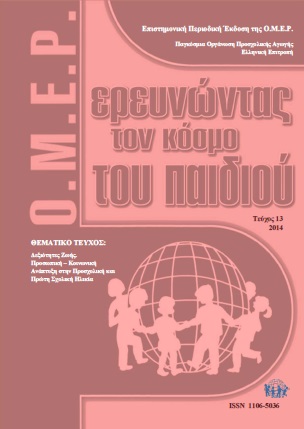ΔΙΔΑΣΚΑΛΙΑ ΕΝΝΟΙΩΝ ΠΙΘΑΝΟΤΗΤΩΝ ΚΑΙ ΣΤΑΤΙΣΤΙΚΗΣ ΣΕ ΕΦΗΒΟΥΣ ΜΕ ΝΟΗΤΙΚΗ ΥΣΤΕΡΗΣΗ

Περίληψη
Η ανάπτυξη της τεχνολογίας έχει επιφέρει αλλαγές στον τρόπο διδασκαλίας των μαθηματικών σε μαθητές με νοητική υστέρηση (Brown et al., 2011). Η παρούσα μελέτη περίπτωσης αποσκοπεί στη διερεύνηση της δυνατότητας των έφηβων με μέτρια νοητική υστέρηση να κατανοούν την τυχαιότητα και να εντοπίζουν το δειγματικό χώρο ενός τυχαίου πειράματος, με τη χρήση της τεχνολογίας. Οι συμμετέχοντες σε αυτή τη μελέτη ήταν δύο έφηβοι με μέτρια νοητική υστέρηση ηλικίας 15 και 16 ετών. Για το σκοπό της έρευνας αναπτύχθηκε μια ιστορία η οποία παρουσιάστηκε στους συμμετέχοντες κάνοντας χρήση του power point. Σύμφωνα με τα αποτελέσματα της μελέτης, οι έφηβοι με μέτρια νοητική υστέρηση ήταν σε θέση να διακρίνουν το δειγματικό χώρο ενός πειράματος τύχης που απαρτίζονταν από ένα έως και τέσσερα διαφορετικά αντικείμενα ενώ αρχικά δεν ήταν σε θέση να περιγράψουν όλους τους δυνατούς συνδυασμούς τριών και τεσσάρων αντικειμένων ανά δύο. Παρ’ όλα αυτά, μπορούν να βελτιώσουν την πιθανολογική σκέψη τους μέσω διδασκαλίας κατάλληλα σχεδιασμένων εκπαιδευτικών δραστηριοτήτων.
Λεπτομέρειες άρθρου
- Πώς να δημιουργήσετε Αναφορές
-
Σιόλου (Evdoxia Siolou) Ε., Λέκκα (Aspa Lekka) Ά., Σακελλαρίου (Maria Sakellariou) Μ., & Παγγέ (Tzeni Pagge) Τ. (2014). ΔΙΔΑΣΚΑΛΙΑ ΕΝΝΟΙΩΝ ΠΙΘΑΝΟΤΗΤΩΝ ΚΑΙ ΣΤΑΤΙΣΤΙΚΗΣ ΣΕ ΕΦΗΒΟΥΣ ΜΕ ΝΟΗΤΙΚΗ ΥΣΤΕΡΗΣΗ. Ερευνώντας τον κόσμο του παιδιού, 13, 487–494. https://doi.org/10.12681/icw.17998
- Ενότητα
- Επιστημονική αρθρογραφία & εκπαιδευτικές δράσεις

Αυτή η εργασία είναι αδειοδοτημένη υπό το CC Αναφορά Δημιουργού – Μη Εμπορική Χρήση 4.0.
Οι Συγγραφείς που δημοσιεύουν εργασίες τους σε αυτό το περιοδικό συμφωνούν στους παρακάτω όρους:
Οι Συγγραφείς διατηρούν τα Πνευματικά Δικαιώματα και χορηγούν στο περιοδικό το δικαίωμα της πρώτης δημοσίευσης ενώ ταυτόχρονα τα πνευματικά δικαιώματα της εργασίας προστατεύονται σύμφωνα με την Creative Commons Attribution License που επιτρέπει σε τρίτους - αποδέκτες της άδειας να χρησιμοποιούν την εργασία όπως θέλουν με την προϋπόθεση της διατήρησης των διατυπώσεων που προβλέπονται στην άδεια σχετικά με την αναφορά στον αρχικό δημιουργό και την αρχική δημοσίευση σε αυτό το περιοδικό.
Οι Συγγραφείς μπορούν να συνάπτουν ξεχωριστές, και πρόσθετες συμβάσεις και συμφωνίες για την μη αποκλειστική διανομή της εργασίας όπως δημοσιεύτηκε στο περιοδικό αυτό (π.χ. κατάθεση σε ένα ακαδημαϊκό καταθετήριο ή δημοσίευση σε ένα βιβλίο), με την προϋπόθεση της αναγνώρισης και την αναφοράς της πρώτης δημοσίευσης σε αυτό το περιοδικό.
Το περιοδικό επιτρέπει και ενθαρρύνει τους Συγγραφείς να καταθέτουν τις εργασίες τους μέσω διαδικτύου (π.χ. σε ένα ακαδημαϊκό καταθετήριο ή στους προσωπικές τους ιστοσελίδες) πριν και μετά από τις διαδικασίες της δημοσίευσης, καθώς αυτό μπορεί να οδηγήσει σε παραγωγική ανταλλαγή ιδεών και σκέψεων καθώς επίσης και σε γρηγορότερη και μεγαλύτερη χρήση και ευρετηρίαση της δημοσιευμένης εργασίας (See The Effect of Open Access).


